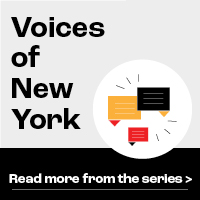
CUNY Baruch College
A Japanese college student on an exchange program at CUNY Baruch shares her story with NY Japion.Read the original story in Japanese at NY Japion
Translated by Rebecca Suzuki
Among the Japanese residents living in New York City are college students on exchange programs. The spotlight so far has been on working adults, but students have also been struggling with the stay-at-home order and campus closures. NY Japion interviewed Ms. Amada, a fourth-year college student who was on an exchange program at CUNY Baruch and is also president of the New York Japan Student Association (NYJSA). She has since gone back to Japan.
Q: You were set to graduate in May, but what is the current situation at the university?
They decided to shut down the school in March, and because it happened so suddenly I got the impression that the instructors were a bit frantic. Some of my professors’ families became ill with the coronavirus, so it seemed like there were more important things than class at that moment.
Spring break was cut short, and we are currently doing distance learning. I am taking a photography class, and it started out as a hands-on class, but since we haven’t been able to develop any photos in the photography lab, the class is now taught in a lecture style. It feels like a completely different class. By the end of March, most of the Japanese exchange students had flown back home, including myself. The professors have been very understanding of the fact that we are not able to attend online lectures due to the time difference. Maybe it’s worse for the school if students dropped their classes. I could sense panic in the emails I receive from my instructors. Maybe this is the worst time for them.
We are also working on a group project that we have to finish before graduation on Zoom.
Q: Why did all of the Japanese exchange students go back to Japan?
I think most people thought, “Japan is safer than New York.” Most thought that they would feel safer getting sick in Japan than in New York, and would get better treatment here. I also hear about a lot of people whose parents told them to come back because they were too worried. When classes switched to distance learning, there wasn’t really a point in staying there, either.
But I do know of some people who are still stuck in New York because they were unable to move out of their apartments in time.
Q: Do you think the current situation will have an impact on your future after graduation?
Fortunately for me, I was already hired to work in Japan post-graduation, so my future hasn’t been impacted. Of course, I am sad that they’ve had to postpone the graduation ceremony that was supposed to happen in May, and I hope to be able to return when they reschedule it. This year, I was networking with people in several industries and even found a sponsor but… I’m disappointed that I’m missing out on possible opportunities to expand my career.
Graduating students who are planning to stay in the U.S. and begin work through optional practical training (OPT) are probably able to stay in the country and work, but those without such plans are probably in a much more precarious situation. I am sure that students who are getting a degree in the arts are worried, because they do not have any guaranteed salaries or health insurance.
Q: What do you think about the current situation in Japan?
Everyone in New York City is staying indoors, but I still see people walking around in Japan, so I feel a bit shocked. Maybe Japanese people don’t truly understand the risk of transmitting to others.
There’s also a gap in how Japanese people perceive the situation in New York. There was a video posted on YouTube by a Japanese woman living in Harlem complaining about the safety of her neighborhood and it went viral. From this video, Japanese people started assuming that New York City is dangerous, but I don’t think this is completely true, at least that’s not what I saw in the neighborhood I lived in…
Q: When you arrived in Japan, how were you treated at the airport?
I took a flight on Japan Airlines, but there were only 18 passengers onboard! They implemented social distancing on the plane and we all sat apart from each other, so I had a relaxing ride.
They made an announcement in the cabin right as we arrived that they were having people wait inside the plane to reduce the crowds in the airport, but the plane I was on arrived at 4 p.m., which is peak time for airport traffic, and I didn’t leave the cabin until 8 p.m. But the flight attendants were very kind to all of us and provided us with drinks and food, so I didn’t mind it so much.
Once I was in the airport, I had to wait in line to be tested for the virus, and I was finally able to leave at 11 p.m. There was no public transport to get out of the airport, so someone had to pick me up, but an employee from the airport had to stay with me while I waited to be picked up. I could see that some people were getting really frustrated, and it created a very strange atmosphere at the airport. I was so relieved when I finally made it home.









